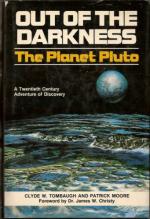|
This section contains 301 words (approx. 2 pages at 300 words per page) |
American Astronomer 1906-1997
Clyde W. Tombaugh, famous for his discovery of Pluto, the solar system's ninth major planet, was born in 1906 in Streator, Illinois. His family moved to Burdett, Kansas, when he was young. In 1928 he sent planetary drawings done using his homemade nine-inch telescope to Lowell Observatory. Its director, Vesto Slipher, was so impressed with the young astronomer's ability to sketch what he saw in a telescope that he offered him a job to conduct the search for a suspected ninth planet. On February 18, 1930, Tombaugh discovered Pluto on two photographs he had taken of the region centered on the star Delta Geminorum. During his fifteen-year sky search, he also discovered the cataclysmic variable star TV Corvi, six star clusters, and a supercluster of galaxies.
 Astronomer Clyde Tombaugh with his homemade, backyard telescope in Las Cruces, New Mexico. Tombaugh's most famous discovery, the planet Pluto, was photographed during a scan of the Delta Geminorum star region.
Astronomer Clyde Tombaugh with his homemade, backyard telescope in Las Cruces, New Mexico. Tombaugh's most famous discovery, the planet Pluto, was photographed during a scan of the Delta Geminorum star region.
After World War II, at the fledgling New Mexico missile site called White Sands, Tombaugh developed the optical telescopes used to track the first rockets of the U.S. space program. In the 1950s he conducted the first and only search for small natural Earth satellites, a contribution to science that will, thanks to modern artificial satellites, be forevermore impossible to replicate.
Tombaugh died just short of his ninety-first birthday at his home in Las Cruces, New Mexico, where he had lived the second half of his productive and interesting life as a professor, writer, and observer.
See Also
Astronomer (Volume 2);; Pluto (Volume 2).
Bibliography
Levy, David H. Clyde Tombaugh: Discoverer of Planet Pluto. Tucson, AZ: University of Arizona Press, 1991.
Stern, S. Alan, and Jacqueline Mitton. Pluto and Charon: Icy Worlds at the Ragged Edge of the Solar System. New York: John Wiley & Sons, 1999.
|
This section contains 301 words (approx. 2 pages at 300 words per page) |


